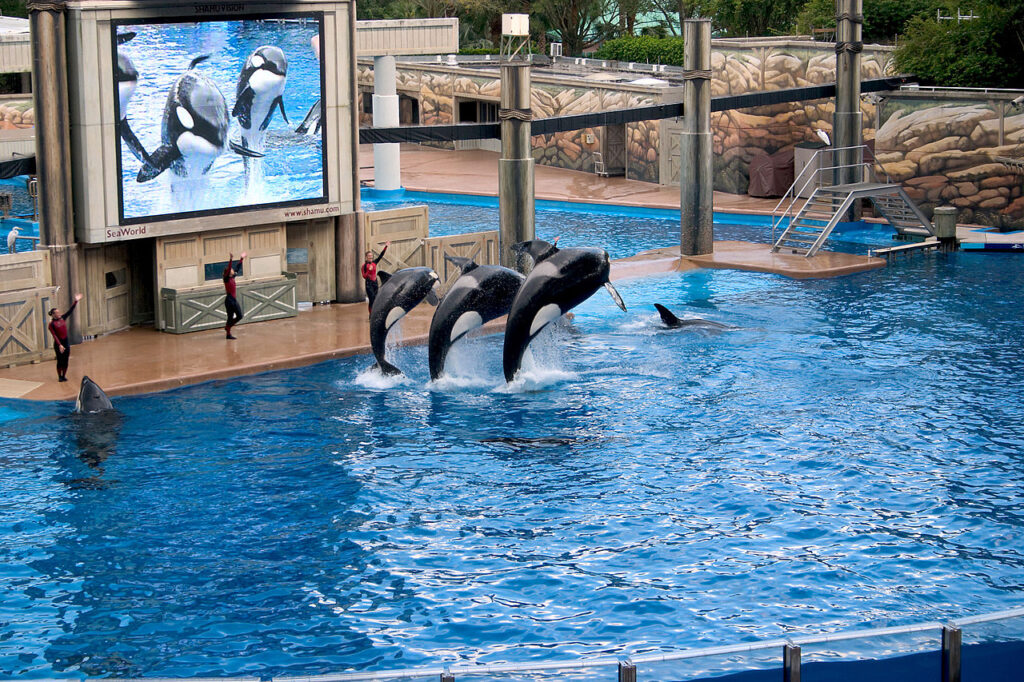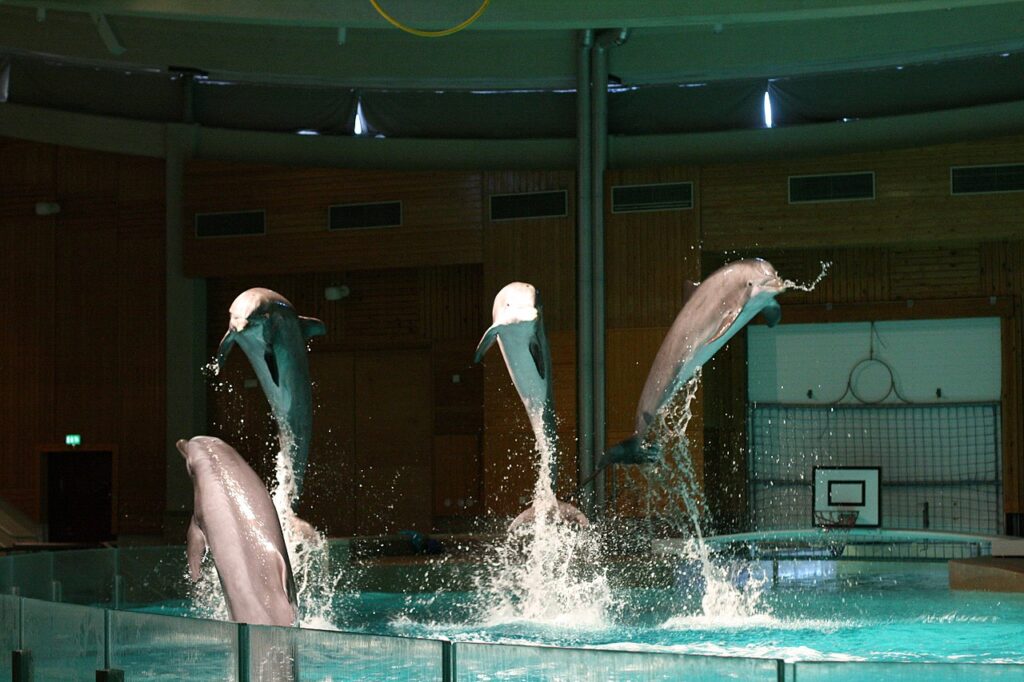Dolphin shows have been a popular tourist attraction for decades. It’s a great way to get up close and personal with some of nature’s most beautiful and intelligent creatures. But what most people don’t know is that these shows come with a hidden cost. Like various captive wildlife attractions, such as Dancing Bears and Temple Elephants, dolphin shows have a dark side. This article will explore the unseen consequences of dolphin shows and uncover the dark side of keeping dolphins in captivity.

What are dolphin shows?
Dolphin shows are performances put on by dolphins trained to do various tricks. The shows often involve the dolphins jumping, spinning, and doing other acrobatic stunts. The shows are typically put on in marine parks and aquariums, but they can also be seen on cruise ships and beach resorts.
Dolphin shows have been around for decades, but in recent years, the industry has come under scrutiny for its treatment of the dolphins involved. As more and more people become aware of the dark side of dolphin shows, many are calling for an end to the practice.
The Positive Effects of Dolphin Shows
Despite the criticism, there are some positive aspects to dolphin shows. For starters, the shows are a great way to educate the public about dolphins and their behavior. Through the shows, people can learn about the animals’ natural behavior and the importance of conservation. Similar reasoning has been used for the values of zoos for conservation.
The shows can also be beneficial to the dolphins themselves. The dolphins in these shows are typically well-cared for and receive regular veterinary care. The trainers also work hard to ensure the dolphins are comfortable and content in their environment.
The Negative Effects of Dolphin Shows
Unfortunately, there are also some negative aspects to dolphin shows. For starters, the shows can be stressful for the dolphins. The animals are often kept in small, enclosed tanks with very little room to swim and explore. This can lead to stress and anxiety in the dolphins, which can cause them to act out or become aggressive.
The shows can also be dangerous for the animals. The stunts the dolphins are trained to do can be physically demanding, and it’s not uncommon for the dolphins to suffer injuries. In some cases, the injuries can be fatal.
How Dolphin Shows Impact Dolphin Populations
Dolphin shows can have a negative impact on dolphin populations. In order to keep up with demand for the shows, many facilities will capture dolphins from the wild and keep them in captivity. This can disrupt the natural balance of the population, as the dolphins taken from the wild can’t reproduce and replace the dolphins that are being taken. Similar issues have been noted for the Kopi Luwak Industry. The world’s most expensive coffee has destroyed civet populations in Indonesia.
The capture and confinement of wild dolphins can also have a long-term impact on their health. Dolphins that are kept in captivity often suffer from mental and physical health issues, such as depression, stress, and disease. In some cases, these health issues can be fatal.
Captive Dolphin Attrition and Mortality Rate
The mortality rate for captive dolphins is significantly higher than for those living in the wild. Studies have shown that dolphins in captivity have a much lower life expectancy than their wild counterparts. This is largely due to the stress and anxiety caused by confinement and the lack of access to a natural environment.
The attrition rates for captive dolphins are also much higher than those of wild dolphins. In some cases, dolphins in captivity may pass away due to disease or injury before they can be replaced. This means that the show may have to be cancelled due to a lack of dolphins, and the captive population may never fully recover.
Captive Dolphins and Their Mental Health
The mental health of captive dolphins is also a major concern. Dolphins are highly intelligent and social animals, and they often suffer from depression and anxiety when confined to small tanks. This can lead to a variety of behavioral issues, including aggression and self-harm.
In some cases, the dolphins may become so stressed and depressed that they refuse to perform the tricks they have been trained to do. This can lead to the show being cancelled and the dolphins being released into the wild, where they may not be able to survive. Nature is great for our own mental health. We must also ensure we are not harming wildlife’s mental health!

The Torture of Captive Dolphins
The captivity of dolphins has also been linked to the torture of the animals. Dolphins in captivity are often subjected to physical and psychological abuse in order to make them perform the tricks they are trained to do. In some cases, the dolphins may be deprived of food or water in order to make them perform better.
The abuse of dolphins in captivity is also linked to the spread of diseases. Dolphins are highly susceptible to a variety of diseases, and the stress of captivity can make them even more vulnerable. This can lead to a higher mortality rate and an increased risk of disease transmission to other dolphins.
The Impact of Captive Dolphins on the Environment
The captivity of dolphins can also have a negative impact on the environment. Captive dolphins often produce waste, which can pollute nearby water sources. This can threaten the health of other marine life and disrupt the natural balance of the ecosystem.
The captivity of dolphins can also lead to the disruption of migratory patterns. Dolphins in captivity may be prevented from migrating to their natural habitats, which can disrupt the natural balance of the population and lead to a decrease in the overall health of the species.
The Reality of Dolphin Shows
The reality of dolphin shows is that they come at a huge cost to the animals involved. The shows can be stressful and dangerous for the dolphins, and they can have a negative impact on their mental and physical health. In some cases, the dolphins may even be subjected to abuse in order to make them perform the tricks they are trained to do.
The captivity of dolphins also has a negative impact on the environment. The waste produced by the animals can pollute nearby water sources, and the disruption of migratory patterns can threaten the health of other marine life.
Conclusion
In conclusion, dolphin shows come with a hidden cost. The shows may be entertaining for the audience, but they can be stressful and dangerous for the dolphins involved. The captivity of dolphins also has a negative impact on the environment, and it can lead to the spread of disease and the disruption of migratory patterns.
If we truly care about the welfare of dolphins, then we must be willing to take a hard look at the impact of dolphin shows. The animals involved deserve to be treated with respect, and it’s up to us to ensure their health and safety.
Help us Help Them! Think Wildlife Foundation is a non profit organization with various conservation initiatives. Our most prominent campaign is our Caring for Pari intiative. Pari is a rehabilitated elephant at the Wildlife SoS Hospital. 25% of the profits from our store are donated to the elephant hospital for Pari. Other than buying our wonderful merchandise, you could donate directly to our Caring For Pari fundraiser.
Written by: Arshaan Shahid
